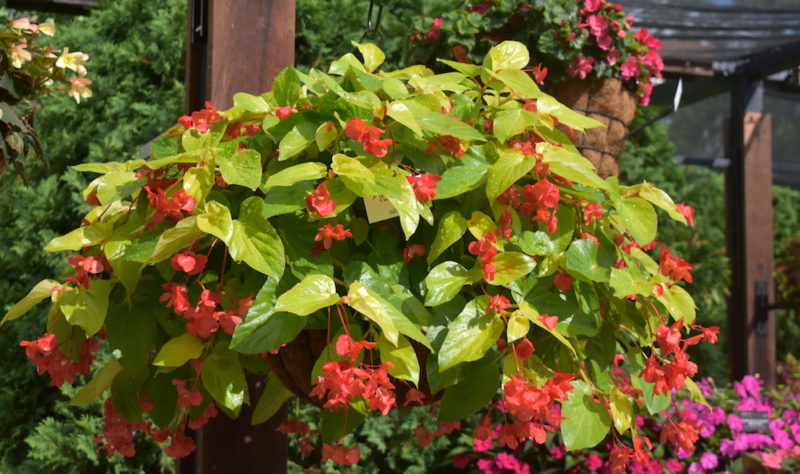
Culture Report: Begonia ‘Canary Wings’
Begonias of all shapes and sizes have exploded onto the market in recent years offering diversity along with the performance customers crave. One introduction this year that truly stands apart is ‘Canary Wings’ begonia. Its unique chartreuse foliage and dark red flowers command attention and brighten up shade gardens, whether used as a stand-alone specimen or used in combination with other shade-loving plants.
Industry and consumer buzz is already growing around this variety. ‘Canary Wings’ won the Retailer’s Choice Award at Cultivate’18, and the February issue of Garden Gate magazine labeled it one of the year’s Best New Plants. This summer, outdoor performance was proven North to South at many university trials, such as the Classic City Award at the University of Georgia. It also took second place in the hanging basket category at North Carolina State University, and earned a very good rating by the Les Exceptionelles Trials in Canada.
‘Canary Wings’ is easy to produce and is very gardener friendly — what a win-win! To produce the best ‘Canary Wings’ in your greenhouse, we offer the following guidelines.
ROOTING & MISTING
Avoid overlapping leaves when sticking to avoid disease issues. To root ‘Canary Wings’, mist for 10 to 15 seconds about every four hours. Avoid any standing water on the leaves; be sure to allow leaves to completely dry before misting again. Maintain relative humidity at 80 percent during propagation. Provide bottom heat at 70° F soil temperature for the first three weeks of rooting, at which time it can be lowered to 65 to 68° F.
Mist should be applied for approximately seven days. If any browning of the edges of the foliage is observed or if they appear pale, too much mist is being applied. Avoid overwatering as this will also encourage fungus gnats. Allowing media to dry moderately after the first week will encourage root growth. Liners should be rooted in five weeks in a 72-size tray. 
MEDIA
As with many crops, use a well-drained, soilless medium. Recommended pH is between 5.4 and 6.0 with an EC of 1.0.
TRANSPLANTING
Place liners with the growing shoot facing outward when placing multiple plants per pot. This helps flowers form on the outside of the container. A 6-inch pot size is the smallest ‘Canary Wings’ is recommended to finish in due to its sizeable habit; however, it can be finished in a 4-inch pot.
TEMPERATURE
Maintain day temperature at 65 to 70° F and night temperature at 60 to 65° F.
LIGHT
During finishing, provide 3,000 to 5,000 foot-candles. ‘Canary Wings’ begonia will flower under natural day length year-round, hence they can be finished in warmer climates during the very early spring months. Note: The flower color will show more of a salmon red instead of a bright red due to lower light intensities. ‘Canary Wings’ will flower approximately two weeks faster under short days than long days. Leaf scorching, curling, and/or reddening of the foliage is a sign that ‘Canary Wings’ is grown under too much light.
WATERING
Growing on the drier side is a good practice for disease control, such as Botrytis. However, do not allow the plants to wilt to avoid delayed flowering, reduced branching and leaf scorch.
FERTILIZER AND PGR
Provide 200-ppm nitrogen once weekly after transplant. And good news for the grower: No PGRs or pinching are needed.
INSECTS
Scout for fungus gnats, particularly in propagation. To everyone’s benefit, ‘Canary Wings’ is not prone to many pests inside or out of the greenhouse, making it an excellent choice for growers and gardeners.
MORE TIPS
‘Canary Wings’ begonia is truly a shade-loving plant. Afternoon sun can cause scorching, particularly if the plants are not kept well-watered. Two to three hours of morning sun can add vibrancy to the flower and leaf color, but be aware of excessive exposure. Acclimation to sun exposure is the key to success with plants grown in brighter environments.
As ‘Canary Wings’ is unique for its bright golden chartreuse foliage, note that as plants become large and mature, the shaded older leaves will slowly become a touch more green adding a beautiful color dimension to the plant.


 Video Library
Video Library 




















